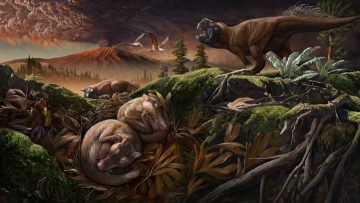Sarah Zhang in The Atlantic:
 One hundred and twenty million years ago, when northeastern China was a series of lakes and erupting volcanoes, there lived a tiny mammal just a few inches long. When it died, it was fossilized down to its most minuscule ear bones. And it is these ear bones that have so intrigued scientists: They are evidence of how evolution created the unique ear of mammals, giving modern mammals—including us—a finely tuned sense of hearing. Today, mammals have three small bones in the ear that transmit sound from the eardrum: the malleus, incus, and stapes. A wealth of evidence from fossils and developing embryos suggests that two of these ear bones were once jawbones. Over millions of years of evolution, they shrank in relative size and detached completely from the jaw. Reptiles—like our nonmammalian ancestors, probably—hear by placing their jaw on the ground to pick up low-frequency vibrations. But mammals, with their three ear bones, can hear high-pitched sounds in the air: insects buzzing, wind rustling, birds squawking, music, speech.
One hundred and twenty million years ago, when northeastern China was a series of lakes and erupting volcanoes, there lived a tiny mammal just a few inches long. When it died, it was fossilized down to its most minuscule ear bones. And it is these ear bones that have so intrigued scientists: They are evidence of how evolution created the unique ear of mammals, giving modern mammals—including us—a finely tuned sense of hearing. Today, mammals have three small bones in the ear that transmit sound from the eardrum: the malleus, incus, and stapes. A wealth of evidence from fossils and developing embryos suggests that two of these ear bones were once jawbones. Over millions of years of evolution, they shrank in relative size and detached completely from the jaw. Reptiles—like our nonmammalian ancestors, probably—hear by placing their jaw on the ground to pick up low-frequency vibrations. But mammals, with their three ear bones, can hear high-pitched sounds in the air: insects buzzing, wind rustling, birds squawking, music, speech.
The fossilized mammal found in northeastern China, named Origolestes lii, has an ear that looks close to modern. While parts of its body still look quite ancient, its ear bones, according to the study’s authors, have moved away and detached from the jaw. “That separation is critical because it allows the separation of hearing and chewing,” says Jin Meng, the curator of fossil mammals at the American Museum of Natural History and an author of the paper. And thus, the ear and the jaw could evolve separately in mammals, each specializing in what it does.
More here.
